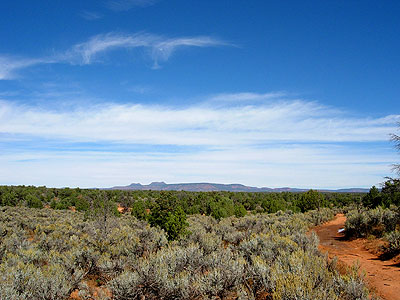
The sun beat down on the Colorado Plateau, but the day was not hot. A slight breeze carried away the heat of the day as I trekked toward my destination. A hidden canyon in southeastern Utah. All around me were the great landmarks of this area: Bears Ears, Sleeping Ute mountain, the Abajo and the Henry mountains were all in sight, as was wing of Shiprock hazy in the distance. Just over the south horizon, beyond sight, was the goosenecks, Valley of the Gods and Monument Valley. But today I wasn't thinking about any of them. I was after a small place. Unknown and fragile.
Years before I had heard rumors about an Anasazi ruin. A cliff dwelling unlike any other. Located deep within the wilderness of southeastern Utah. It's row of rooms hidden behind a front wall, shielded in a twilight alley. "Muuyaw kiihu'at" is my Hopi translation for the name of this hidden place. For years I had wanted to visit this place. On my last trip to Utah I promised myself I would.
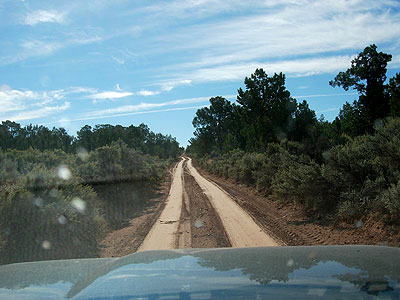
To just get to the canyon where it waits in silence I had to drive 8 miles over a sometimes sandy, sometime rutted dirt road. It had rained hard two nights before and in places there were puddles so deep I didn't think my truck would make it through. Mud splattered everywhere as I plowed through the huge puddles of wet earth, covering my vehicle with a slip of red Utah mud. Surprisingly the toughest parts were over the harder slickrock. The hard packed rock tossed my truck around like a child's toy, along with me and my kidneys as well. Then the road became impassable, a deep rut through which I could not drive. It was time to get out of the truck and walk the last mile, through sage and rabbit brush, and an ever present forest of Juniper and Pinyon tress. Abbey would be proud.
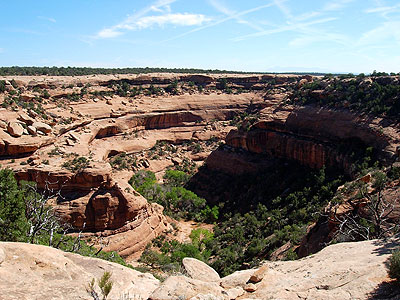
At last I reached the canyon. I had been warned that the ruin would still be hidden from view until I hike down a ways. Carefully following the cairns down the steep slickrock, I gently lowered myself over the lip of a dry waterfall, a pour-over, on to a pile of loose rocks that had been placed there, as a step, by those who had made this pilgrimage before me.
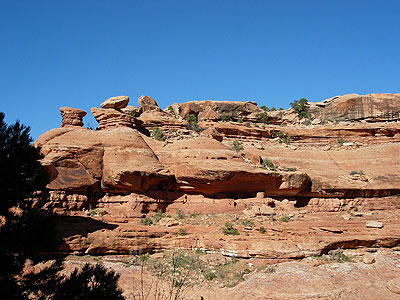
Finally, as I rounded a bend, my goal came into view, tucked away in an alcove on the other side of the canyon. I couldn't even begin to imagine how a human being could get across, but I kept going along the rough slickrock that hovered on the rim, trusting the trail. Hard rock gave way to gritty red earth as the trail began to descend down a talus slope. Dirt crushed from the house sized boulders that towered above me.
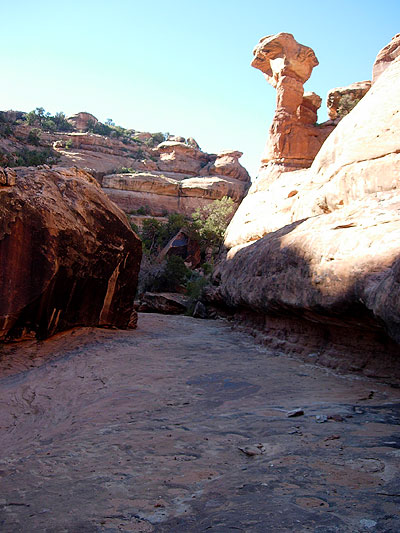
Finally I made it to the bottom. Hidden from the sun the it was dark and cool. The walls and floor had been polished smooth by centuries of floods racing through the canyon. I carefully started up the other side towards the ruins. Going up slickrock cliffs has always seemed easier to me than coming down, and this was no exception, but I was back in the sun and there was no wind here in the depths of the canyon. Sweat was pouring off my face, my heart was pounding. The cliff face got steeper and harder to climb. Was I crazy? Would the ruins be as magical as I had imagined for so long? Suddenly, just as I thought I would never make it never, I peered over a lip of rock and there, in front of me, was my destination:
The Ruins
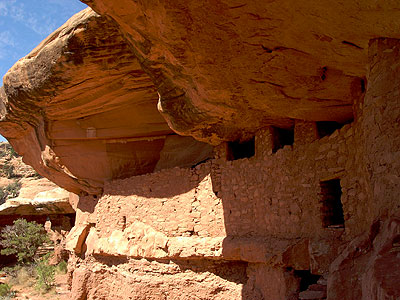
Muuyaw kiihu'at".
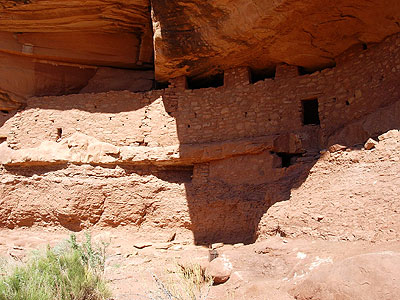
Dating to about AD 1260, the ruin itself was made up of three sections. The main one appearing as a slightly curved wall from the outside. Blank but for small Loop Holes and a little door. The door beckoned me, but I waited to take it all in, and catch my breath, before I entered
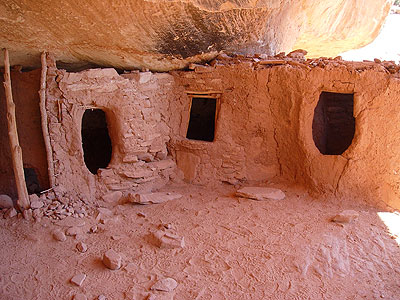
To the right three large rooms with horse collar doors stood in silence. Their doorway like dark eyes waiting for their builders to return.
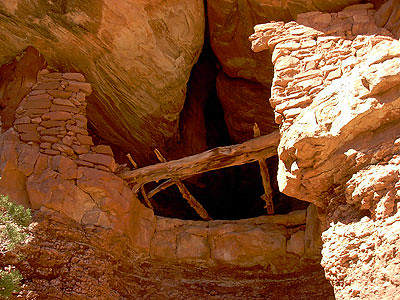
To the left of the main section were the remains of rooms that had long ago collapsed.
The Pictographs
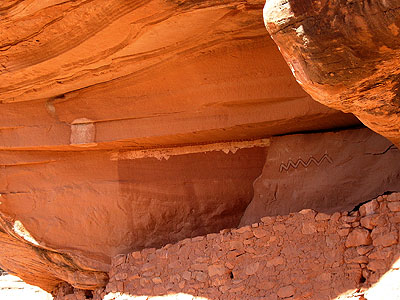
Above the main section were three very well preserved pictographs, or rock paintings. The one on the left a large white circle or shield, the one in the middle a band of white with two pairs of downward pointing triangles and a line of white dots running along the top, and on the right a zigzagging horizontal line.
As I stood there in front of these I wondered what they were trying to tell me. Was the circle a shield of war as many ruins have? Was it the Sun or the Moon? What was the white band with the dots and triangle?
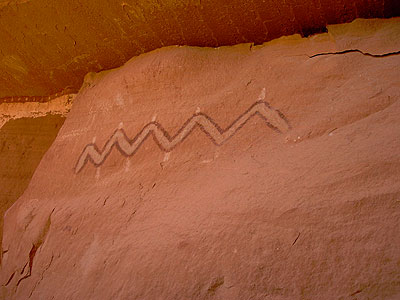
Was the zigzagging line a snake or perhaps a chain of mountain peaks used to mark the passing of the sun throughout the year? Whatever they meant, I had the distinct feeling they were announcing those who had once lived here. Like an ancient address, a sign, or perhaps to strangers, a warning.
The Interior
My mind moved away from the mysteries of the pictograph when I climbed through the little door in the center wall. There I entered into a dark, secret alleyway behind the front facade of the wall.
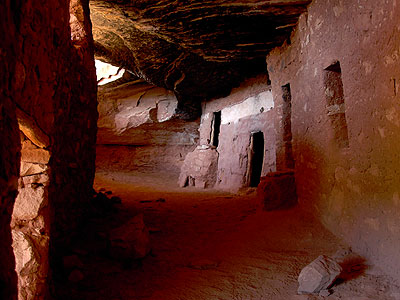
In the dim light shafts of sunlight filtered through the door and the small holes in the outer wall, illuminating five sheltered and hidden rooms. The secrets of "Muuyaw kiihu'at".
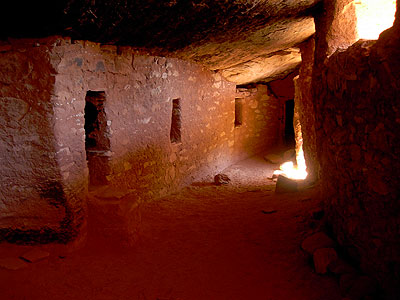
The air was filled with echoes of the Ancient Ones as fine dust rose from under my feet. The silence and magic of neglected centuries permeated the walls. Broken only by the call of a distant Raven.
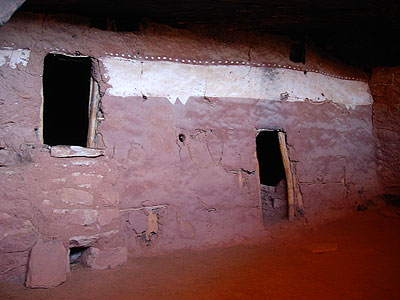
Along the wall in the middle of the alley, over the central door, was the same white band with downward pointing triangles and dots that hung outside the ruin. The paint as fresh as if it had been done the day before. A wonderfully preserved motif that was repeating itself. I marveled at it's rarity as well as it's simple beauty.
The Kiva
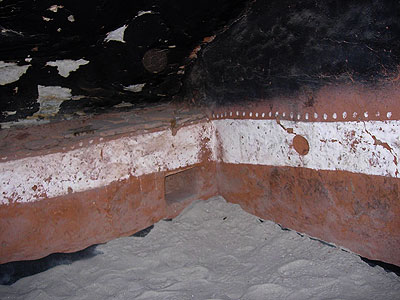
Peering with my flashlight though the central door into a darkened middle room, I could barely make out the now familiar white band and dots, which now ran around all four interior walls! This version lacked the triangles, but instead had what looked to be three unpainted circles, floating in the band of white. There was also a niche in the back wall, which itself had a shelf built into it's entire length. The thought, "Kiva", immediately came to mind. Was this small square room a Kiva? The repeating motif of the white band certainly made this room special.
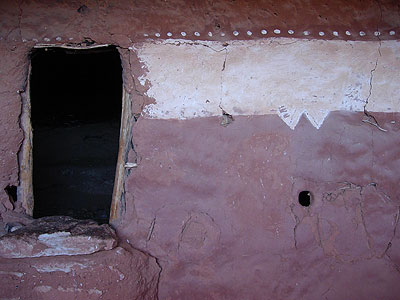
Adding to the mystery, the white band in the alleyway had two triangles pointing down toward a hole in the wall of the room on the left. It's doorway having been sealed up halfway for some unknown reason.
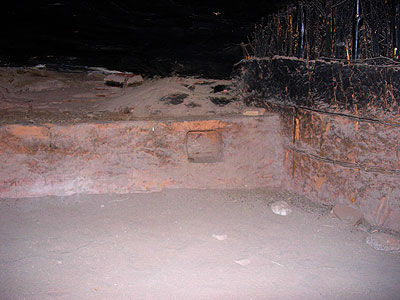
Like the center room, this room also had a small niche and shelf in the back wall but lacked the painted white band. What was the meaning of the hole in the wall? Does light shine through it on a special day, like a solstices? Did it relate to the small so called Loop Holes holes in the front facade wall?
The Loop Holes
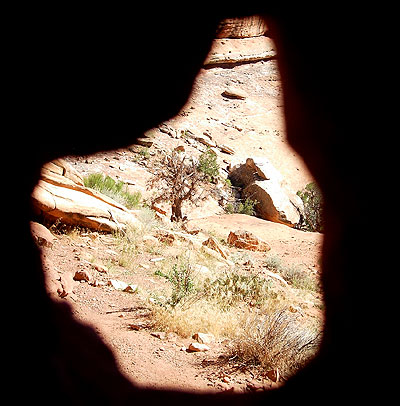
From the inside of the ruin it seemed obvious to me that the view through the Loop Holes covered all approaches to the ruin. Anyone hiding behind the wall could easily see all of the canyon outside without exposing themselves. Why would they be hiding? Did they fear an attack, and if so, from who? I kept thinking about the paintings on the outer wall. The way they hung like a warning over the structure. Were the pictographs there to announce something, frighten someone or both?
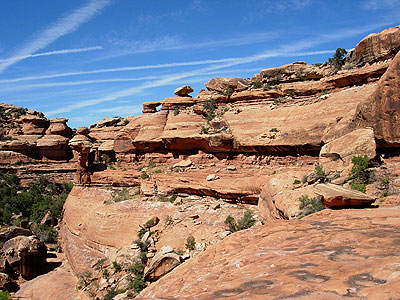
The rumors had been true, his was a very special place.
The Anasazi flute returns
I spent the whole day there. Exploring other ruins in the canyon and then as the day waned returning to "Muuyaw kiihu'at" to play my "Anasazi" flute.
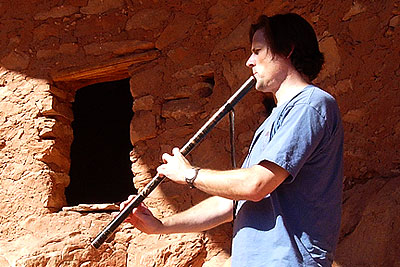
As discussed in the previous post, this flute had been recreated from a handful of flutes found throughout the four corners area dating back 700 - 1,500 years ago. This is the flute that the Ancient Ones had once played here. Kokopelli's flute. As the sound reverberated off the canyon cliffs I realized that the this flute had not been heard in this canyon in over 700 years. That I was the first person to play this kind of flute here since the inhabitants of this canyon fled south centuries ago. A chill ran through my body as the echoes seemed to fade away, back in time. As I continued to play the warmth of the flute's tranquil tones filled the ruins and the canyons. It's sound being reborn and with it, the spirits of the canyon.
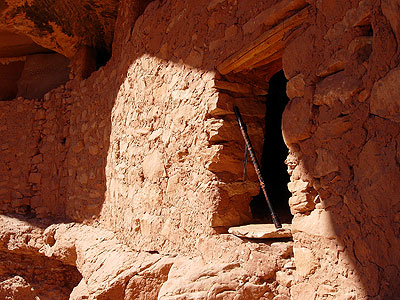
Yellow Light of Dawn
Listen To a sample of the Anasazi flute from the song Yellow Light of Dawn.
The complete version of Yellow Light of Dawn is a free mp3 download available to members of my E-mailing list. Becoming a member is free and easy.
Sign up here.
You and also listen to sample of all my recordings and other Native American flutes by going to the Music Page at www.scottaugust.com.
To find out more information about Native American flutes and Native American flute music check out my Native American flute History page as well.
This was a special experience that you sure deserved to have to yourself. The photos are well done and tell a story of their own in addition to your personal memory of the day. Thanks, in part, to your interest, perhaps more folks will understand the unequaled contribution early cultures made to our world.
ReplyDelete